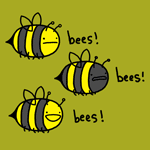I receive a lot of calls for bee removals at this time of year.
This is a lousy time of year to remove honeybees, and, believe me, it’s a tough challenge to encourage homeowners to live throughout the winter with their hive of bees as housemates.
Asking some people to live with their honeybees is sort of like asking them to live with their cancer for a little while longer (yes, I know this analogy falls short because cancer is serious business and honeybees are simply a nuisance, but go with me on this one).
Usually, the bees have been living undetected in the home for some time. So, it’s not as if this is something that needs to be addressed immediately. For some reason, however, simply KNOWING about the bees’ presence seems to instill a sense of urgency in their removal.
However, if we can keep our wits about us, we will make better decisions…decisions based on information and made with a cool head.
In just a few weeks, the honeybees in Ohio will cluster. They’ll be quiet. They’ll stop flying around the doorframe or the windowsill or from the attic where they’ve previously been so active. They will simply live out their winter in a quiet ball of sweet humming. Over the winter, the population of the hive will slowly decrease. And that great store of honey they’ve collected all summer will dwindle as the colony slowly consumes it.
If we were to remove the bees right now, the bees could not survive—removals are hard on the bees, and they need some nurturing from their beekeeper to recover from it…and this late in the season, they don’t have time to reestablish themselves before winter hits. So, even though we can rid the house of bees, we would lose the bees entirely. And my priority is to establish a viable hive from whatever bees I remove.
If I can convince the homeowner to wait until late March (or after) to part company with their bees, we would find three things beneficial to a successful removal:
- There are far fewer bees to remove because the hive population dwindles over the winter (this also translates into less expense for the homeowner).
- There is far less honey to deal with because the colony eats through the stored honey over the winter. Therefore, there’s far less mess to clean up from the space in which the colony overwintered (this also translates into less expense for the removal). It also means far less honey remains behind to draw ants, mice, and other pests which the homeowner surely wants to avoid.
- Most importantly, if we remove the bees and all their honeycomb in the spring, the hive stands every chance to recover and thrive and pollinate and produce local honey (a portion of which is usually gifted back to the homeowner). In the spring, we would expect a healthy, vibrant hive to carry on once it’s re-hived and re-established in a bee yard where it can forage and flourish. Doesn’t that make you happy, Reader?


